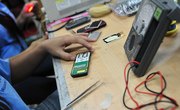
Energy exists in two forms, kinetic and potential. Potential energy sources include chemical, mechanical, nuclear and gravitational and are stored energy forms. Kinetic energy is considered "working" energy and includes sound, motion, light and heat and electricity, according to the U.S. Energy Information Administration. You can use experiments to show kids how energy works.
Lemon Power
Turn a lemon into an energy source known as a voltaic battery, which changes one energy form into another. The lemon contains chemical energy that converts into electrical energy when you add one copper wire and one steel wire to it. Use a small sheet of sandpaper to even out the edges of both the steel and copper wires. Keep the lemon whole and rub it gently between your hands before inserting the copper and steel wires. Get the wires as close together as possible, but do not allow them to touch each other. Once you have the wires poked into the lemon, place your wet tongue on the tips of both wires at the same time. You will feel a small tingle once your tongue touches the wires, as you have now completed the circuit.
Heat up a Balloon
Find out how warm air acts differently from cold air using an experiment that tests warm air's effects. Most people can blow up a balloon by mouth, but with a deflated balloon, a plastic bottle and a pan of hot water your kids can see how hot air makes things rise. Place the balloon over the bottle mouth and place the bottle in the pan. The experiment shows how warm air uses more space than cold air and illustrates how molecules move to inflate the balloon without adding additional air.
Water Purification
Use a simple outdoor experiment to demonstrate the sun's energy. Water purification is a process in which you remove impurities to create a drinkable product. In this experiment, fill a bowl with regular tap water but add strong spices like curry or garlic to "taint" the flavor of the water. Place a small cup in the center of the bowl, cover the bowl with plastic wrap and set a small rock on top. Once you place the experiment in a well-lit area outside, the sun's energy will cause water vapors to form, and over a period of time, create drinkable water. This simple steam distillation process works because the vapors cling to the plastic wrap, travel to the center where the rock is and drip down into the cup.
Potential Energy
Establish the concept of potential energy using several objects like pebbles, empty cans and wooden blocks. The experiment's purpose reveals how height and weight affect potential energy. Some of the items will demonstrate gravitational energy and others will identify a moving object's energy. There are several factors to consider when calculating the height and weight of an object and its potential energy; increasing or decreasing the weight or height of an object affects its energy. Some of the experimental items can be dropped, swung or moved side-to-side to determine their potential energy.
References
About the Author
Annabeth Kaine began writing in 2010 with work appearing on various websites. She has successfully run two businesses, held chairmanship positions on two fund-raising committees and received excellence-in-service awards for both. Kaine is completing her Bachelor of Arts in psychology.
Photo Credits
NA/Photos.com/Getty Images
